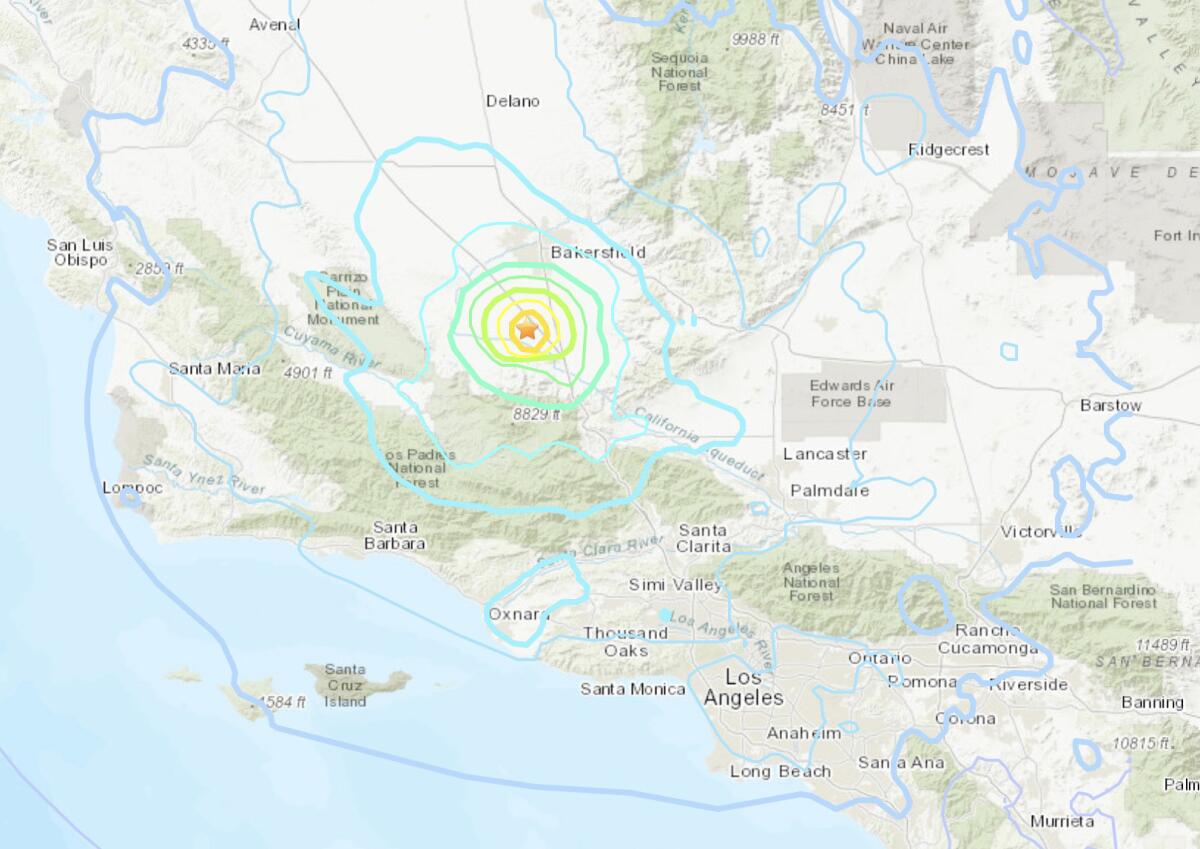It was the strongest SoCal quake in three years. Here’s why it packed such a punch in L.A.

A magnitude 5.2 earthquake, centered about 18 miles southwest of Bakersfield, was felt across a wide swath of Southern California on Tuesday night.
Its size rattled nerves but caused no major damage or injuries. Two minutes after the earthquake hit, a large boulder — the size of an SUV — was reported blocking multiple southbound lanes of Interstate 5, about a mile south of Grapevine Road, the California Highway Patrol said. The boulder was cleared by Wednesday morning.
The earthquake, originally estimated at magnitude 5.3, struck at 9:09 p.m., according to the U.S. Geological Survey. It was followed by dozens of aftershocks of magnitude 2.5 and up, including a magnitude 4.5 earthquake that occurred less than a minute after the first, and a magnitude 4.1 temblor at 9:17 p.m.
The epicenter was in sparsely populated farmland, about 14 miles northwest of the unincorporated community of Grapevine in Kern County, 60 miles northwest of Santa Clarita, and about 88 miles northwest of downtown Los Angeles.
The area closest to the epicenter felt “very strong” shaking as defined by the Modified Mercalli Intensity Scale; that zone includes a section of the California Aqueduct, which transports water from Northern California to Southern California.
By the time shaking was felt in more populated areas, including Bakersfield, Santa Clarita and Ventura, the USGS calculated that only “weak” shaking was felt, which can rock standing cars and cause vibrations in a building similar to the passing of a truck.
Some residents affected by the quake reported an extended period of shaking. One person in Los Feliz felt 45 seconds of movement, with at least three different waves — one weak, followed by a strong one, then again a weak one. In South Pasadena and Whittier, people felt about 20 seconds of shaking, contained in two distinctive waves.
In Pasadena, seismologist Lucy Jones said she felt about three seconds of shaking.
There were no immediate reports of damage. And not everyone felt the earthquake. L.A. County Sheriff’s Deputy Jose Gomez said he didn’t feel the shaking during his drive into work at the sheriff’s Santa Clarita station. No damage was reported there.
The Los Angeles Fire Department said no significant damage was reported within city limits. Preliminary inspections of the State Water Project facilities, including the California Aqueduct, found no damage.
The USGS said the quake was felt across the Los Angeles Basin and inland valleys and in Santa Maria, Bakersfield and Fresno.
Many Southern California residents described getting alerts from the USGS’ earthquake early warning system, such as through the MyShake app or on their Android phones. (The earthquake early warning system is automatically installed on Android phones, but people with Apple iOS phones need to install the MyShake app to get the most timely alerts.)
One person described getting 30 to 45 seconds of warning before feeling the shaking arrive. Another person, in east Anaheim, reported 30 seconds of warning before shaking arrived.
Jones, a research associate at Caltech, said the duration of shaking can vary so much in the L.A. area because the length of time the earth moves at any given spot can depend on the soil and rocks beneath the location, whether a person is sitting still or moving around, and even whether an individual is on the ground floor or on top of a skyscraper — those on higher floors feel the shaking more strongly.
The reason some people may have felt more than one wave of shaking is that the first aftershock occurred so soon — less than a minute — after the main shock, Jones said.
Geophysics professor Allen Husker, head of the Southern California Seismic Network at Caltech, said it wasn’t surprising that so many people in the L.A. area felt significant shaking from a magnitude 5.2 earthquake north of the Grapevine. The temblor occurred at night, when people are resting and more likely to feel shaking from a distant quake than if they were out and about during the day and active.
Another reason many people felt substantial movement is due to the way shaking is amplified in the Los Angeles Basin. The basin is a 6-mile-deep, bathtub-shaped hole in the underlying bedrock filled with weak sand and gravel eroded from the mountains and forming the flat land where millions of people live. It stretches from Beverly Hills through southeast L.A. County and into northern Orange County.
“The basin effect ... increases the shaking that you would otherwise normally have,” Husker said.
The effect happens when waves from the shaking arrive and hit the walls of the basin, then bounce back at the walls of the basin, Jones said, resulting in an “extended duration.”
A major earthquake on the San Andreas fault would result in perhaps 50 seconds of strong shaking in downtown L.A. “This earthquake was much, much smaller, of course,” Jones said, “but it was large enough to set up some of these basin effects and get things bouncing around.”
As with all earthquakes, there was a 1 in 20 chance that Tuesday’s temblor was a foreshock to a larger earthquake. The risk that a follow-up quake will be larger diminishes over time.
Earthquakes are a way of life if you live in Los Angeles. But what about when you never feel them — even as your Shake Alert is blaring and your friends are buzzing about the temblor?
It has been several years since a magnitude 5.2 or greater earthquake hit Southern California, and Tuesday’s quake was the strongest to strike the region in three years. A magnitude 5.3 quake occurred in June 2021 just southeast of the Salton Sea in Imperial County, about 160 miles southeast of downtown Los Angeles. And in June 2020, a magnitude 5.5 quake struck the Mojave Desert in the northwestern corner of San Bernardino County, about 120 miles northeast of downtown L.A. and about 14 miles east of Ridgecrest in Kern County.
The earthquake occurred about 12 miles northwest of the epicenter of the magnitude 7.5 Kern County earthquake that struck on July 21, 1952. That earthquake resulted in 12 deaths, and, according to the USGS, old and poorly built masonry buildings suffered damage. Some of those structures collapsed in communities including Tehachapi, Bakersfield and Arvin; heavy damage was reported at Kern County General Hospital.
Shaking from the 1952 earthquake was felt as far away as San Francisco and Las Vegas, and caused nonstructural but extensive damage to tall buildings in the Los Angeles area and damage to at least one building in San Diego, according to the USGS.
The 1952 earthquake occurred on the White Wolf fault. Tuesday’s earthquake wasn’t associated with any previously mapped faults.
Times staff writers Jon Healey, Ian James, Jason Neubert, Sandra McDonald and Raul Roa contributed to this report.
More to Read
Sign up for Essential California
The most important California stories and recommendations in your inbox every morning.
You may occasionally receive promotional content from the Los Angeles Times.











